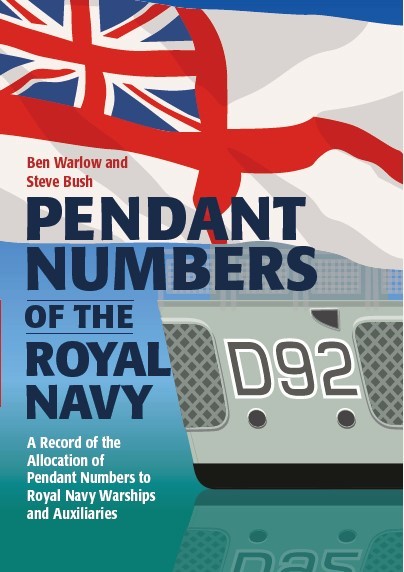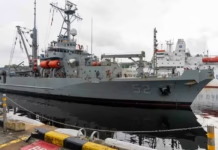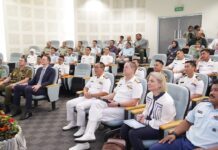
Pendant numbers of the Royal Navy – A Record of the Allocation of Pendant Numbers to Royal Navy Warships and Auxiliaries. By Ben Warlow and Steve Bush. Seaforth Publishing, Barnsley, UK. ISBN 978-1-5267-9378-2
Reviewed by David Hobbs
Notwithstanding its title, this book actually has a much wider focus and it includes the pendant numbers used by all the Commonwealth navies for much of the twentieth century. They were allocated within a common system that allowed ships to operate seamlessly together and to be transferred between navies.
It therefore includes every RAN warship and auxiliary that fought in the two world wars and Korea up to the point where the present system of hull numbers was introduced. It also includes ships of the Canadian, New Zealand and South African navies and even allied warships that served under Admiralty control in the Second World War. The authors acknowledge the help they were given by the Sea Power Centre – Australia in their extensive research. They also worked with the US Naval Archive Centre to confirm pendant numbers allocated to the British Pacific Fleet between 1944 and 1946 which were generated in USN signal publications passed to the BPF through the RAN signal organisation.
The book is divided into four sections. The first is an introduction that explains the origins of the pendant numbers painted on the hulls of warships which were first used to differentiate between similar-looking ships such as torpedo boat destroyers that were coming into service early in the twentieth century. They also facilitated their rapid identification during fleet manoeuvres. Numbers with differing flags superior were also allocated to larger warships but not painted on their hulls; they were displayed, when necessary as flag hoists. The various different systems introduced by the Admiralty and especially the current system introduced in 1948 are described and I was pleased to read the authors’ explanation of the origin of the term pendant number. Flags that are longer then they are broad were originally described as pendants because of their tendency to hang down. Over time the adjective became a noun pronounced as pennant and spelling changed to reflect this. Today either spelling is deemed to be correct. The more traditional word pendant is used throughout the book.
The second section lists surface and submarine fleet pendant numbers in number order through the various flags superior starting with 00 which was first allocated to the battleship Dreadnought between 1906 and 1916. Other examples include the battlecruiser Australia which was allocated the number 09 between January and April 1918 and the destroyer Warramunga which was allocated the number D 123 between 1948 and 1959. The third section lists pendant numbers allocated to the British pacific Fleet in the US Navy Visual Callsign Book DNC 4(A) and examples include the destroyers Nizam, D68, Queenborough, D72, and Quickmatch, D75. A speculative list of the ‘A’ series pendant numbers probably allocated to the RAN Bathurst class is included in this section. The eighteen ships of this class that served with the BPF were listed in DNC 4(A) with ‘B’ series numbers but at least two were photographed with ‘A’ series numbers, for instance Tamworth, B250/A124. So too have escort carriers such as Ruler, A731, but the authors have been unable to find the source of the ‘A’ numbers despite extensive research in the UK, Australia and the USA. The Bathurst class list is based on the most likely allocation and agrees with ships identified by the RAN Ship History Section which is aware that Geraldton was allocated A116.
The final section lists pendant numbers by ship name in alphabetical order and where a ship had different pendant numbers though its life these are all shown. For instance the cruiser Australia was at various times allocated the pendant numbers C30, D84 and I84. Cross reference to section two reveals the exact dates when these were allocated; Australia‘s D84, for instance, being allocated between 1940 and 1945. The illustrations are of high quality and include HMAS Bendigo with the pendant number B237.
Ben Warlow and Steve Bush also created the latest edition of Ships of the Royal Navy, updating the work of the late J J Colledge, and this new book complements it perfectly. It is the result of decades of research and must be considered as the definitive work on the subject. References and a bibliography are listed but there is no need for an index as ships are listed alphabetically in section four. Prior to this book it was not always easy to identify un-named photographs of Commonwealth warships using the pendant numbers painted on their hulls; often several sources such as Jane’s Fighting Ships had to be consulted depending on the assessed age of the image. Now there is a single authoritative source that makes identification possible and it should be included in every naval historical library. Seaforth Publishing are to be congratulated for recognising the potential value of this unique publication and producing it at a very reasonable price. I thoroughly recommend it as an essential reference work for anyone with an interest in naval history.



